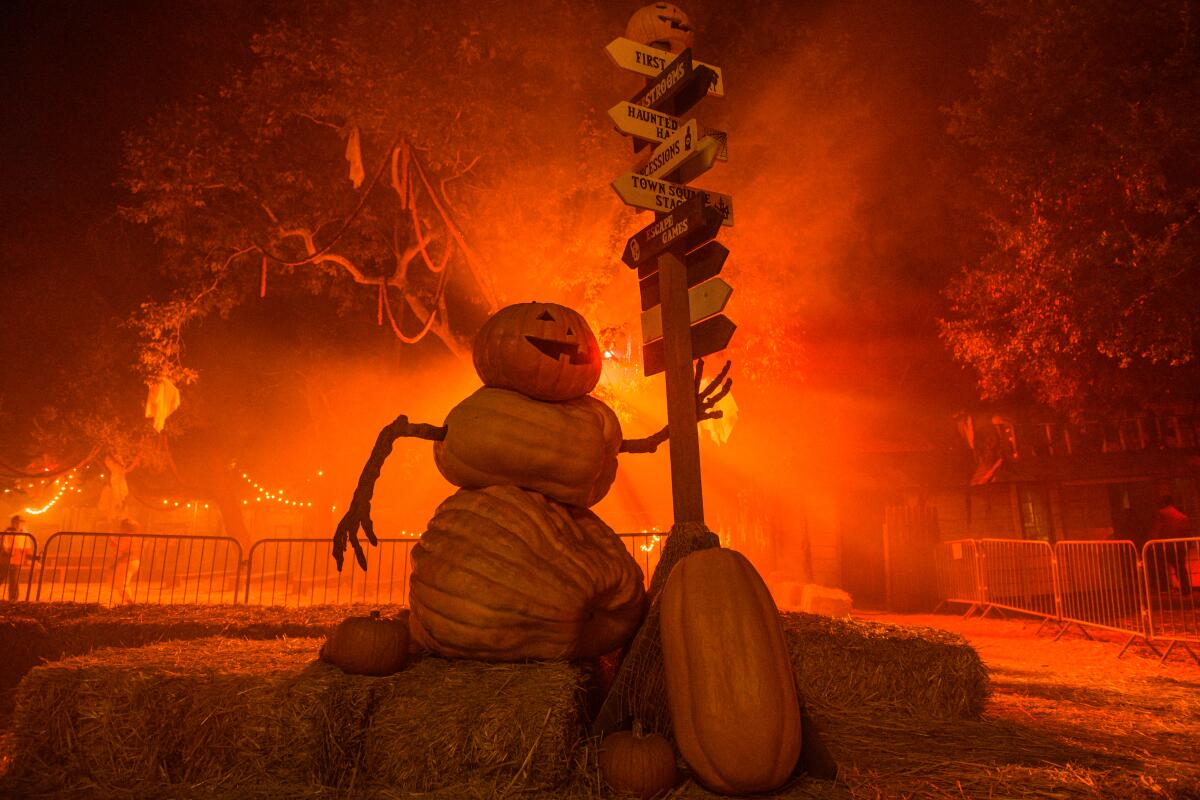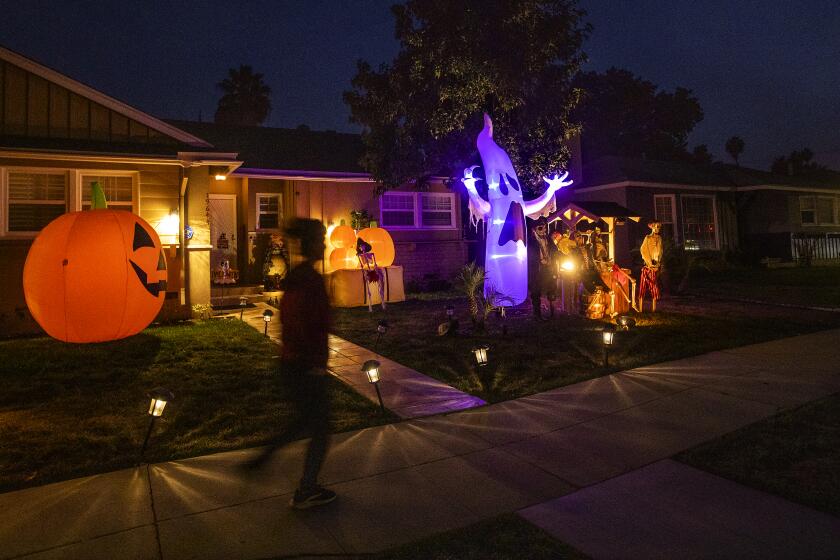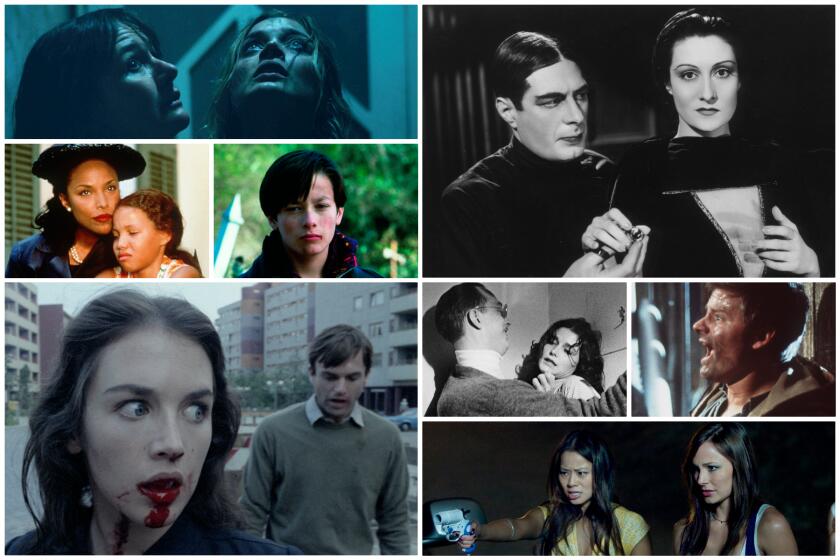Editorial: Halloween urban legends can do serious harm. Why do we still believe them?

- Share via
First, the story was that Halloween candy was poisoned, perhaps by witches and goblins (or wicked neighbors) out to kill young children. After that 1960s myth faded, it was followed by the insistence that candy was filled with needles and razor blades, so that hungry young 1970s trick-or-treaters would have their insides cut up like something out of a horror movie. And when that didn’t happen, the 21st century line was that on every Halloween some doors are opened by child molesters who lure costumed kids inside to abuse them.
These are urban legends — modern-day tales of monsters and hidden dangers, attributed to a friend’s neighbor’s boyfriend’s aunt, told and retold until they become common knowledge attested to by millions, even though they’re untrue. In this supposedly sophisticated era, our myths do away with ghosts and ghouls and substitute in criminals and other scary real-life humans: mentally ill people, serial killers somehow paroled because of dangerous liberal reforms or court rulings, sex offenders.
These false tales, taken as truth, blend seamlessly into the spirit of this festive night: a dose of fear and chill to make the candy taste all the sweeter. And could there possibly be any harm in spreading a few lies about the supposed criminals lurking among us?
That’s the problem. There is indeed harm done. There are no verified reports of any registered sex offender ever snatching any trick-or-treater on Halloween, yet lawmakers and police have made Oct. 31 crackdowns a regular part of the night’s observances, ostensibly to keep children safe.
Should I open my doors on Halloween or hide guiltily inside? Is it safe to face the crowds of hundreds of children who show up on my street?
Until recently, some California cities required registered sex offenders to publicly identify themselves with signs on their doors in a sort of shaming ritual meant to warn children away. A court finally struck down that requirement, which endangered the people on the list and protected no one — because, again, there are no reported instances of any of them harming trick-or-treaters.
Yet the California Department of Corrections and Rehabilitation still requires anyone on the sex-offender registry who is on active parole (and remember, there are many on the list who are not and never were pedophiles, and whose crimes had nothing to do with children) to observe special Halloween rules: They may not put up decorations or carve jack-o’-lanterns, and must turn out the lights to make it look like no one’s home, not give out candy and in fact not answer the door for anyone but a law enforcement officer. Since 1994, the CDCR’s version of “Operation Boo” has sent agents to handcuff paroled sex offenders on Halloween night, search their homes and make arrests for various parole violations. Agents even have special shirts to celebrate the event, and they pitch their Oct. 31 operations to local TV news outlets to demonstrate how they’re keeping us safe.
They make a point of noting that since they began this annual ritual, “instances of sexual abuse have not been prevalent on Halloween.” Of course, they weren’t “prevalent” before they began these checks, either. It’s like the old joke about the man constantly tapping two sticks together and explaining, on being asked, that he’s doing it to keep the lions away. “But there are no lions for hundreds of miles,” he’s told. His reply: “See how well it works!”
The real impact of programs like Operation Boo is not to make us safer but to ramp up fear, give an official governmental stamp of approval to an untrue urban legend and, in the process, generate public support for police. In other states, news outlets get in on the act, publishing maps showing the homes of sex offenders, further marginalizing people who long ago served their time for their crimes. Resources that ought to fight actual deadly dangers in the community, like dangerous driving or poorly lighted streets, fight fake problems instead.
Perhaps the original tale of a child snatched at the neighbor’s door comes from 13th century England, where Little Sir Hugh kicked his ball over the neighbor’s wall and knocked on the door to get it back. The woman who answered offered the child tasty treats to lure him inside, where she killed him in — according to this antisemitic urban legend and ballad — a supposed Jewish blood ritual. King Henry III gave credence to this lie, many Jews were killed in response, and by the end of the century all Jewish people were expelled from England. That’s how an urban legend, seasoned with fear and hatred, can turn into shocking and lasting injustice.
Like so many other moments of 2020, we’ll celebrate a new version of Halloween this year.
Couldn’t happen here, in the modern era? Consider the day care panic of the 1980s, in which false accusations of satanic ritual abuse riveted the nation’s attention, consumed an enormous amount of law enforcement resources and ruined lives. The current QAnon conspiracy continues the paranoid tradition, melding fake stories of satanic day care rituals with Little Sir Hugh by positing that the Hollywood elite and prominent Democrats abduct children and frighten them in order to enhance a substance in their blood, which they then drain and consume. This urban legend has entered political campaigns and could alter the outcome of elections.
Take a measure of fear over people’s differences — their race or religion, for example — and mix in some deep anxiety over a deadly disease or other perceived dangers and you’re well on the way to turning an urban legend into mass hysteria. It’s all in good frightening fun until someone is executed, as in the 17th century Salem witch trials. Or their lives are destroyed, as in the McCarthy era, skillfully but frighteningly depicted as Salem in Arthur Miller’s “The Crucible.”
The enemy of false urban legends is data. For example, in the face of stories about rampant shoplifting leading to closures of chain stores, the numbers tell us that shoplifting has in fact declined. The San Francisco Chronicle recently reported on other reasons that Walgreen Co. may be closing its stores in that city, such as poor business decisions and oversaturation. This urban legend appears to be much more complex.
Others assert that not just shoplifting, but indeed all crimes are down, but that too is a sort of urban legend in reverse. Violent crime, including murder, is indeed sharply up in those communities that have long suffered from the most violence. That’s where we need to direct our attention and resources, not to phantom crimes.
Perhaps the greatest danger from urban legends is that you can never completely dismiss them. Hospitals and police have wasted millions on their silly “service” of X-raying Halloween candy to detect hidden hazards and never found any; yet the fact-checking website Snopes.com tells us there have indeed been some cruel pranks reported that involved sharp but ultimately non-injurious objects stuck in candy. And we do indeed live in a world in which some some horrid people put deadly poison in Tylenol and sent lethal anthrax spores through the mail.
Horror filmmakers, icons and experts name the most underappreciated horror films of all time.
There are plenty of things to terrify us, but we’re obliged to examine the rumors and separate the urban legends from the facts before our fear and gullibility do others — and ourselves — serious harm.
Trick or treating was scarce last year because of the pandemic, which this year is still with us but now better controlled with vaccines and knowledge. It’s probably OK (although maybe still a bit scary) to go to your neighbor’s door, or to answer your own and give out treats. But the real reason for caution is the lingering virus, not monsters snatching children or spiking candy. But it’s Halloween, so for heaven’s sake, wear a mask. Not just to be frightening, but to keep yourself and the rest of us safe.
More to Read
A cure for the common opinion
Get thought-provoking perspectives with our weekly newsletter.
You may occasionally receive promotional content from the Los Angeles Times.













